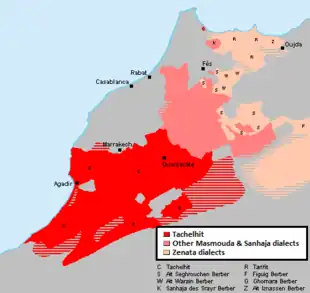Idioma tashelhit
El tashelhit (también llamado tachelhit, tachlhit, shilha, chilha, chelha, chalha o chleuh) es el mayor idioma de las lenguas bereberes de Marruecos por número de hablantes (dependiendo del autor que se consulte, 3 millones[2] o entre 8 y 9 millones[1]) y por la extensión de su área. El chilha se habla en el sur de Marruecos en el área que va desde las laderas del Alto Atlas a las laderas meridionales del Anti-Atlas limitado al occidente por el océano Atlántico. Los límites orientales del chilha son difíciles de precisar por su gradual transición hacia el Tamazight del Marruecos Central.
| Chilha, Tachelhit | ||
|---|---|---|
| Tacelḥit | ||
| Hablado en |
| |
| Hablantes |
8 a 9 millones [1] Nativos
Otros Desconocido
| |
| Puesto | No en los 100 mayoresLugar número (Ethnologue, 2013) | |
| Familia | ||
| Escritura | escritura árabe, alfabeto latino y tifinag (Tachelhit in Latin script y Tachelhit in Tifinagh script) | |
| Códigos | ||
| ISO 639-2 | shi | |

Comparación léxica
La siguiente tabla contiene algunos cognados en idioma cabilio (taqbaylit), en idioma rifeño (tarifit) y en lengua tachelhit:[3][4]
| GLOSA | cabilio | chilha | rifeño |
|---|---|---|---|
| 'árbol' | tejṛa | taddagt | ta-šejar-t |
| 'flor' | ajeĝĝig | ajddig | ta-nuwaš-t |
| 'piel' | agʷlim | ilm | irem |
| 'cuerno' | icc (sing) acciwn (pl) | isk (sing) iskwen (pl) | |
| 'suero de leche' | iɣi | aɣu | aɣi |
| 'mantequilla' | udi | tudit | trussi |
| 'harina' | awren | aggurn | aren |
| 'ceniza' | iɣed | iɣḍ | nifest |
| 'luna' | agur | ayyur | yur |
| 'hoy' | assa | ɣassa | nhara |
| 'carta' | tavṛaṭ | tabrat | tabrat |
| 'hija' | yelli | illi | yelli |
| 'pequeño' | amezyan | imẓẓiy | amezyan |
| 'rojo' | azgʷaɣ | azggʷaɣ | azeggʷaɣ |
| 'izquierdo' | azelmaḍ | aẓlmaḍ | azelmaḍ |
| 'vivir' | idir | iddr | dder |
| 'comer' | ečč | icc | eš |
| 'escupir' | susef | sufs | skufes |
| 'mirar' | muqel | smuql | khza |
| 'quedarse' | qqim | ɣumu | qqim |
| 'dejar' | eĝĝ | ajj | eĝĝ |
| 'enterrar' | nṭel | mḍl | ndar |
| 'quemar' | ṛeɣ | jdr | sešmed |
| 'preguntar' | seqsi | saqsa | seqsa |
| 'vosotros' | kunwi | kunni | kenniw |
| 'vosotras' | kunemti | kuninti | kennimt |
| 'con' | yid | diyiḍ | ag |
Referencias
- Stroomer, 2008.
- Lewis, 2009.
- Hamimi, 1997, pp. 377-389.
- Lamuela, 2002, pp. 115-136.
Bibliografía
- Hamimi, Gaya (1997). Grammaire et conjugaison amaziɣ. Paris: Harmattan. ISBN 2-7384-5406-2.
- Lamuela, Xavier (2002). El Berber. Barcelona. ISBN 84-393-6956-5. (enlace roto disponible en Internet Archive; véase el historial, la primera versión y la última).
- Lewis, M. Paul, ed. (2009). «Ethnologue report for language code:shi». Ethnologue: Languages of the World (16 edición). Dallas, Tex.: SIL International.
- Stroomer, Harry (2008). «Three Tashelhiyt Berber Texts from the Arsène Roux Archives». En Kortlandt, F.H.H.; Lubotsky, Alexander; Schaeken, Jos et al., eds. Evidence and Counter-Evidence. Essays in Honour of Frederik Kortlandt. 2: General Linguistics. (Studies in Slavic and General Linguistics). Ámsterdam: Rodolpi. ISBN 978-90-420-2471-7. «In Morocco, Berber is spoken in the Rif (Tarifit), in the Middle Atlas (Tamaziyt) and in the High Atlas, the Sous plains and the Anti-Atlas (Tasusiyt, Tashelhit), by an estimated 45% of the total population of 30 million people... Berber immigrant communities of various origins have settled in France, Belgium, the Netherlands, Germany and Israel. Of all Berber languages Tashelhit Berber is the one with the highest (estimated) number of speakers: some 8 to 9 million. »
Enlaces externos
Este artículo ha sido escrito por Wikipedia. El texto está disponible bajo la licencia Creative Commons - Atribución - CompartirIgual. Pueden aplicarse cláusulas adicionales a los archivos multimedia.